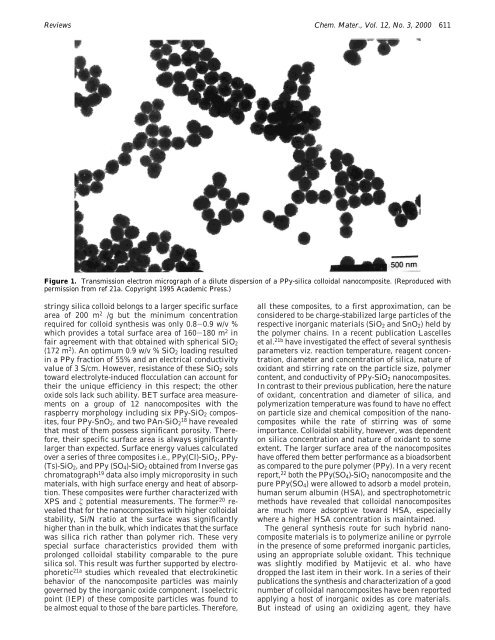Conducting Polymer Nanocomposites
Conducting Polymer Nanocomposites
Conducting Polymer Nanocomposites
You also want an ePaper? Increase the reach of your titles
YUMPU automatically turns print PDFs into web optimized ePapers that Google loves.
Reviews Chem. Mater., Vol. 12, No. 3, 2000 611<br />
Figure 1. Transmission electron micrograph of a dilute dispersion of a PPy-silica colloidal nanocomposite. (Reproduced with<br />
permission from ref 21a. Copyright 1995 Academic Press.)<br />
stringy silica colloid belongs to a larger specific surface<br />
area of 200 m 2 /g but the minimum concentration<br />
required for colloid synthesis was only 0.8-0.9 w/v %<br />
which provides a total surface area of 160-180 m 2 in<br />
fair agreement with that obtained with spherical SiO2<br />
(172 m 2 ). An optimum 0.9 w/v % SiO2 loading resulted<br />
in a PPy fraction of 55% and an electrical conductivity<br />
value of 3 S/cm. However, resistance of these SiO2 sols<br />
toward electrolyte-induced flocculation can account for<br />
their the unique efficiency in this respect; the other<br />
oxide sols lack such ability. BET surface area measurements<br />
on a group of 12 nanocomposites with the<br />
raspberry morphology including six PPy-SiO2 composites,<br />
four PPy-SnO2, and two PAn-SiO2 18 have revealed<br />
that most of them possess significant porosity. Therefore,<br />
their specific surface area is always significantly<br />
larger than expected. Surface energy values calculated<br />
over a series of three composites i.e., PPy(Cl)-SiO2, PPy-<br />
(Ts)-SiO2, and PPy (SO4)-SiO2 obtained from Inverse gas<br />
chromatograph 19 data also imply microporosity in such<br />
materials, with high surface energy and heat of absorption.<br />
These composites were further characterized with<br />
XPS and potential measurements. The former 20 revealed<br />
that for the nanocomposites with higher colloidal<br />
stability, Si/N ratio at the surface was significantly<br />
higher than in the bulk, which indicates that the surface<br />
was silica rich rather than polymer rich. These very<br />
special surface characteristics provided them with<br />
prolonged colloidal stability comparable to the pure<br />
silica sol. This result was further supported by electrophoretic<br />
21a studies which revealed that electrokinetic<br />
behavior of the nanocomposite particles was mainly<br />
governed by the inorganic oxide component. Isoelectric<br />
point (IEP) of these composite particles was found to<br />
be almost equal to those of the bare particles. Therefore,<br />
all these composites, to a first approximation, can be<br />
considered to be charge-stabilized large particles of the<br />
respective inorganic materials (SiO2 and SnO2) held by<br />
the polymer chains. In a recent publication Lascelles<br />
et al. 21b have investigated the effect of several synthesis<br />
parameters viz. reaction temperature, reagent concentration,<br />
diameter and concentration of silica, nature of<br />
oxidant and stirring rate on the particle size, polymer<br />
content, and conductivity of PPy-SiO2 nanocomposites.<br />
In contrast to their previous publication, here the nature<br />
of oxidant, concentration and diameter of silica, and<br />
polymerization temperature was found to have no effect<br />
on particle size and chemical composition of the nanocomposites<br />
while the rate of stirring was of some<br />
importance. Colloidal stability, however, was dependent<br />
on silica concentration and nature of oxidant to some<br />
extent. The larger surface area of the nanocomposites<br />
have offered them better performance as a bioadsorbent<br />
as compared to the pure polymer (PPy). In a very recent<br />
report, 22 both the PPy(SO4)-SiO2 nanocomposite and the<br />
pure PPy(SO4) were allowed to adsorb a model protein,<br />
human serum albumin (HSA), and spectrophotometric<br />
methods have revealed that colloidal nanocomposites<br />
are much more adsorptive toward HSA, especially<br />
where a higher HSA concentration is maintained.<br />
The general synthesis route for such hybrid nanocomposite<br />
materials is to polymerize aniline or pyrrole<br />
in the presence of some preformed inorganic particles,<br />
using an appropriate soluble oxidant. This technique<br />
was slightly modified by Matijevic et al. who have<br />
dropped the last item in their work. In a series of their<br />
publications the synthesis and characterization of a good<br />
number of colloidal nanocomposites have been reported<br />
applying a host of inorganic oxides as core materials.<br />
But instead of using an oxidizing agent, they have

















